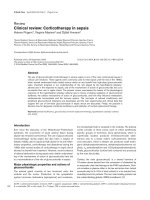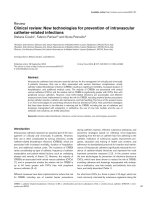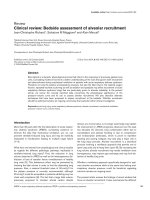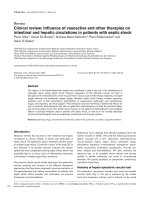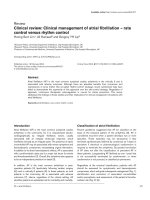Báo cáo khoa học: "Clinical review: New technologies for prevention of intravascular catheter-related infections" pdf
Bạn đang xem bản rút gọn của tài liệu. Xem và tải ngay bản đầy đủ của tài liệu tại đây (59.02 KB, 6 trang )
157
CRBSI = catheter-related bloodstream infection; C-SS = chlorhexidine and silver sulfadiazine; CVC = central venous catheter; M-EDTA = mino-
cycline and EDTA.
Available online />Introduction
Intravascular catheters represent an essential part of the man-
agement of critically and chronically ill patients. However,
their use is often complicated by serious infections, mostly
catheter-related bloodstream infections (CRBSIs), which are
associated with increased morbidity, duration of hospitalisa-
tion, and additional medical costs. The incidence of CRBSI
varies considerably by type of catheter, frequency of catheter
manipulation and patient-related factors, such as underlying
disease and severity of illness [1]. However, the majority of
CRBSIs are associated with central venous catheters (CVCs)
[1], and in prospective studies the relative risk for CRBSI is
up to 64 times greater with CVCs than with peripheral
venous catheters [2–4].
Different measures have been implemented to reduce the risk
for CRBSI, including use of maximal barrier precautions
during catheter insertion, effective cutaneous antisepsis, and
preventive strategies based on inhibiting micro-organisms
originating from the skin or catheter hub from adhering to the
catheter. Institution of continuous quality improvement pro-
grams, education and training of health care workers, and
adherence to standardized protocols for insertion and mainte-
nance of intravascular catheters significantly reduced the inci-
dence of catheter-related infections and represent the most
important preventive measures [1,2]. In the present review
the new technologies for prevention of infections directed at
CVCs, which have been shown to reduce the risk of CRBSI,
including catheters and dressings impregnated with antisep-
tics or antibiotics, new hub models, and antibiotic lock solu-
tions, are briefly described (Table 1).
For short-term CVCs (i.e. those in place <10 days), which are
most commonly colonized by cutaneous organisms along the
Review
Clinical review: New technologies for prevention of intravascular
catheter-related infections
Stefania Cicalini
1
, Fabrizio Palmieri
2
and Nicola Petrosillo
3
1
Resident, 2nd Infectious Diseases Unit, Istituto Nazionale per le Malattie Infettive ‘Lazzaro Spallanzani’, IRCCS, Rome, Italy
2
Resident, 2nd Infectious Diseases Unit, Istituto Nazionale per le Malattie Infettive ‘Lazzaro Spallanzani’, IRCCS, Rome, Italy
3
Director, 2nd Infectious Diseases Unit, Istituto Nazionale per le Malattie Infettive ‘Lazzaro Spallanzani’, IRCCS, Rome, Italy
Correspondence: Stefania Cicalini,
Published online: 29 September 2003 Critical Care 2004, 8:157-162 (DOI 10.1186/cc2380)
This article is online at />© 2004 BioMed Central Ltd
Abstract
Intravascular catheters have become essential devices for the management of critically and chronically
ill patients. However, their use is often associated with serious infectious complications, mostly
catheter-related bloodstream infection (CRBSI), resulting in significant morbidity, increased duration of
hospitalization, and additional medical costs. The majority of CRBSIs are associated with central
venous catheters (CVCs), and the relative risk for CRBSI is significantly greater with CVCs than with
peripheral venous catheters. However, most CVC-related infections are preventable, and different
measures have been implemented to reduce the risk for CRBSI, including maximal barrier precautions
during catheter insertion, catheter site maintenance, and hub handling. The focus of the present review
is on new technologies for preventing infections that are directed at CVCs. New preventive strategies
that have been shown to be effective in reducing risk for CRBSI, including the use of catheters and
dressings impregnated with antiseptics or antibiotics, the use of new hub models, and the use of
antibiotic lock solutions, are briefly described.
Keywords catheter-related bloodstream infections, central venous catheters, new technologies, prevention
158
Critical Care June 2004 Vol 8 No 3 Cicalini et al.
external surface of the catheter, the most important preven-
tive systems are those that decrease the extraluminal contam-
ination. In contrast, with long-term CVCs (i.e. those in place
>10 days), in which endoluminal spread from the hub
appears to be the primary mechanism of infection, technolo-
gies that reduce endoluminal colonization in addition to extra-
luminal invasion of the catheter should provide additional
protection against CRBSI.
Method
This report is based on a literature review of published arti-
cles in the prevention of intravascular catheter-related infec-
tions. The review was conducted by searching the Medline
database of the National Library of Medicine, Bethesda, MD,
USA using the following key terms: catheter-related infec-
tions, catheter-related bloodstream infections, intravascular
devices, central venous catheter, prevention, infection control
practices, guidelines, and new technologies. The bibliogra-
phies of selected articles were also reviewed for pertinent
studies.
Antimicrobial impregnated catheters and
dressings
Chlorhexidine impregnated sponge dressing
A sponge dressing impregnated with chlorhexidine gluconate
(BioPatch
®
; Johnson and Johnson, Arlington, TX, USA)
applied at the insertion site of CVCs has been shown to
reduce skin colonization and bacterial migration along the
external surface of the catheter as compared with skin disin-
fection with povidone–iodine [5]. Therefore, it may be effec-
tive for the prevention of infections associated with short-term
CVCs, in which extraluminal colonization is the primary mech-
anism of infection. However, local contact dermatitis to the
BioPatch
®
dressing has been observed in low-birth-weight
neonates, who require prolonged central access during the
first 2 weeks of life [5].
Silver impregnated subcutaneous collagen cuff
A silver impregnated collagen cuff attached to CVCs and left
below the skin insertion site significantly decreased the risk
Table 1
New technologies for the prevention of central venous catheter-related bloodstream infection
Technology Usefulness Grade* Note
Antimicrobial impregnated dressings
Chlorhexidine impregnated sponge dressing Short-term CVCs NR Consider for CVCs expected to be in place for
>5 days
Silver impregnated subcutaneous collagen cuff Short-term CVCs NR Conflicting results in several clinical trials of
efficacy
Antimicrobial impregnated catheters IB Consider if institutional rate of CRBSI is high
despite consistent application of preventive
measures and CVC is expected to be in
place for >5 days
Chlorhexidine–silver sulfadiazine impregnated catheters Short-term CVCs Only the external surface of the CVC is
coated. Not effective for CVCs left in place
for >2 weeks
Minocycline–rifampin impregnated catheters Short-term and long-term Both the internal and external surfaces of the
CVCs CVC are coated. Prolonged antimicrobial
activity
Hubs
Catheter hub contained a iodinated alcohol solution Long-term CVCs NR A recent trial failed to show any preventive
benefit from the use of this hub
Povidone–iodine satured sponge Long-term CVCs NR
Needleless connectors NR Increased risk for CRBSI associated with
improper use
Antimicrobial lock solutions Long-term CVCs II Consider only for patients with recurrent
CRBSIs despite consistent application of
preventive measures
*Adapted from the Centers for Disease Control and Prevention guidelines for the prevention of intravascular catheter-related infections [1].
Category IB: strongly recommended for implementation and supported by some experimental, clinical, or epidemiologic studies, and a strong
theoretical rationale. Category II: suggested for implementation and supported by suggestive clinical or epidemiologic studies or a theoretical
rationale. NR: no recommendations for or against use at this time. CRBSI, catheter-related bloodstream infection; CVC, central venous catheter.
159
for extraluminal colonization associated with short-term
catheters (mean duration of placement <10 days) [6,7]. The
ionic silver has broad spectrum activity against bacteria and
fungi, and the cuff provides a mechanical barrier to the migra-
tion of micro-organisms along the external surface of the
catheter [1]. Nevertheless, clinical trials involving short-term
CVCs have yielded conflicting results [6–9]. In two random-
ized clinical trials conducted in surgical patients assigned to
receive a CVC with or without a silver cuff [7,8], the inci-
dence of CRBSI was significantly greater in the control than
in the cuffed catheter group (3.7% versus 1%). In the third
clinical trial [9], however, no difference in the rates of catheter
colonization or incidence of CRBSI was observed between
patients who received and those who did not receive a silver
cuffed CVC. Moreover, the cuff failed to reduce CRBSIs
associated with catheters left in place for 20 days or longer
[6,10,11]. This may be attributable to the biodegradable
nature of the collagen and to the fact that the silver ions
chelated to the cuff are released within 3–7 days. In addition,
in this setting intraluminal spread from the hub is the domi-
nant mechanism of catheter colonization. Another potential
problem with the cuff is the protrusion of the system after
insertion if the physician does not have sufficient experience
with the insertion technique.
Catheters impregnated with antimicrobial agents
Several studies have shown that CVCs impregnated with
antiseptic or antibiotic agents decreased the risk for catheter
colonization and CRBSIs [12–16] in comparison with unim-
pregnated catheters [14,15]. The best studied antimicrobial
catheters are those impregnated with a combination of
chlorhexidine and silver sulfadiazine (C-SS) or minocycline
and rifampin [15,17].
Chlorhexidine and silver sulfadiazine impregnated catheters
Catheters coated with C-SS have been shown to decrease
the risk for colonization by twofold and the risk for CRBSI by
at least fourfold compared with uncoated catheters [14]. The
main limitations of these catheters is that only the external
surface of the catheter is coated, thus conferring no protec-
tion from micro-organisms invading the internal surface of the
catheter from contaminated hubs, and that the catheters have
reduced antimicrobial activity and poor efficacy with long-
term use (>2 weeks) [18–20]. Thus, these catheters have
been shown to be particularly efficacious in reducing the risk
for CRBSI associated with short-term CVCs [17] but failed to
reduce the risk for CRBSI in situations requiring long-term
catheterization [19]. In the largest clinical trial [19], which
included 538 patients randomly assigned to receive a C-SS
impregnated catheter or a nonimpregnated catheter, in which
the mean duration of catheterization was 20 ± 12 days, no
significant difference in the incidence of CRBSI was
observed between the control group (4.7%) and the C-SS
catheter group (5%) [19]. However, catheters impregnated
intraluminally with chlorhexidine in addition to C-SS extralumi-
nal impregnation are now available, and preliminary studies
indicate their prolonged antimicrobial activity and improved
efficacy in preventing infections [21].
C-SS impregnated catheters are more expensive than stan-
dard catheters, but they should reduce costs in settings in
which the incidence of CRBSI is greater than 3.3 per 1000
catheter-days [14], despite adherence to other preventive
strategies. A cost-effectiveness analysis concluded that using
these catheters would decrease direct medical costs by
US$196 per catheter inserted [17].
Resistance to the antiseptic components of this device has
not been demonstrated in clinical studies [14]. There is
concern about the potential anaphylaxis associated with the
use of C-SS impregnated catheters, probably related to the
chlorhexidine component, and 12 cases of anaphylactic reac-
tions have been reported from Japan [22], and one case from
the UK [23]. However, there have been no reports of such
reactions from the USA, where more than 3 million catheters
were sold during 2000 [24].
Minocycline–rifampin coated catheters
Catheters coated with minocycline–rifampin have the advan-
tage of coating both the internal and external surfaces of the
catheters, and have been associated with a lower rate of infec-
tion than have C-SS impregnated catheters. In a prospective
clinical trial in which patients were randomly assigned to
receive either minocycline–rifampin or C-SS catheters, the rate
of CRBSI was significantly lower in the former group than in
latter group (0.3% versus 3.4%) [25]. Indeed, catheters coated
with minocycline–rifampin exhibited broad spectrum inhibitory
activity both in vitro and in vivo against Gram-positive bacteria,
Gram-negative bacteria, and Candida albicans that was signifi-
cantly superior to that with C-SS impregnated catheters [20].
Moreover, the antibiotic activity of minocycline–rifampin is
retained for longer periods in situ [15,20,25,26]. Although
more expensive than C-SS impregnated catheters, a recent
analysis suggested that CVCs coated with
minocycline–rifampin are cost-effective for patients catheter-
ized for at least 1 week and lead to overall cost savings when
patients are catheterised for 2 weeks or longer [27].
Although no resistance to the antimicrobial components of
these devices has been demonstrated in clinical studies
[15,25], an in vitro study demonstrated a 10- to 16-fold
increase in the minimal inhibitory concentration of the minocy-
cline–rifampin combination with respect to Staphylococcus
epidermidis, suggesting that resistance to this combination
can develop. The study also indicated that minocycline had a
protective role against development of rifampin resistance,
because resistance to rifampin increased only 80-fold when
rifampin was used in combination with minocycline, in con-
trast to 25 000-fold when rifampin was used alone [28].
However, a thorough investigation is required to determine
the risk for emergence of resistance to minocycline–rifampin
associated with long-term use of these catheters.
Available online />160
Polyurethane catheters
Polyurethane catheters combined with silver, carbon and plat-
inum (oligon-treated catheters) represent a new option for the
prevention of CRBSI. In a prospective randomized trial,
Ranucci and coworkers [29] compared the rates of CVC col-
onization and CVC bloodstream infections between 268
patients with an oligon-treated catheter and 277 patients with
a polyurethane catheter treated with benzalkonium chloride.
Patients in the oligon group demonstrated a lower risk for
catheter colonization (relative risk 0.63, 95% confidence
interval 0.46–0.86; P = 0.003), whereas no significant differ-
ences in CVC bloodstream infections were found between
the oligon and the control groups.
Silver iontophoretic device
Another technology is the silver iontophoretic device, in
which silver ions are released through a low voltage current
to carbon-impregnated CVCs [30] or through silver wires that
are attached to the proximal segment of a silicone catheter
[31]. Although this technology has been shown to prevent
catheter infections [20,31], the clinical safety and efficacy of
this device have not been demonstrated.
Hubs and needleless connectors
Catheter hub containing a iodinated alcohol solution
A catheter hub containing an antiseptic chamber filled with
3% iodinated alcohol has been shown to reduce the rate of
CRBSIs by fourfold compared with a standard hub model
[32]. This model will be most useful with long-term CVCs, in
which hub and lumen colonization are the leading causes of
CRBSI. On the other hand, a recent clinical trial failed to
show any benefit from the use of this hub in preventing
CRBSI [33].
Povidone–iodine saturated sponge
Another model, which uses a povidone–iodine connection
shield to encase the catheter hub, showed a significant reduc-
tion in the rate of CRBSI as compared with a control hub (0%
versus 24%; P <0.05) in a randomized controlled clinical trial
involving patients receiving total parenteral nutrition [34].
Needleless connectors
The use of needleless intravenous access devices, introduced
to reduce the risk associated with occupational exposure of
health care workers to blood-borne pathogens [35], was asso-
ciated with an increased rate of CRBSI [36–38], which may
be related to improper handling and inaccurate use of these
devices [39]. However, the potential for needleless connec-
tors to increase the risk for CRBSI is uncertain, and recent
clinical trials have shown that these devices do not increase
the risk for infection [40] when they are used correctly and in
combination with rigorous aseptic techniques.
Antimicrobial lock solution
Antimicrobial lock is a novel technique in which an antimicro-
bial solution, often consisting of an anticoagulant along with
an antibiotic agent, is instilled into the lumen of the catheter
and allowed to remain for a defined period, usually
6–12 hours, after which it is removed. Antimicrobial lock solu-
tions have shown to be mostly effective for the prevention of
infections associated with long-term CVCs [41,42] but they
could also be useful in short-term catheters [43].
Various antimicrobial agents have been shown to be effica-
cious in reducing the risk for infection, including
vancomycin–heparin and vancomycin–ciprofloxacin–heparin
solutions [42,44]. Because the use of vancomycin is an inde-
pendent risk factor for the acquisition of vancomycin-resistant
enterococci [45], this practice is not recommended for
routine use [1]. However, in individual cases in which a
patient requires indefinite vascular access but continues to
experience CRBSIs despite rigorous observance of infection
control measures, the use of vancomycin lock solution to pre-
serve vascular access should be considered. A novel lock solu-
tion consisting of minocycline and EDTA (M-EDTA) has also
been shown to have antimicrobial activity against the most
common organisms associated with CRBSI, including Gram-
positive and Gram-negative bacteria and Candida albicans,
resulting in prevention of infection [46]. In a prospective cohort
study, M-EDTA proved to be efficacious in preventing port-
related infections without causing any adverse events [47].
However, randomized clinical trials are needed to test further
the ability of M-EDTA to prevent long-term CVC infections.
Prophylactic thrombolysis
Prophylactic use of anticoagulant agents, including heparin or
warfarin, reduced the incidence of catheter thrombosis
[20,41,42]. Because thrombi could serve as a nidus for
microbial colonization of CVCs [48,49], the use of anticoagu-
lants may have a role in the prevention of CRBSI. For
example, in a double-blind randomized controlled study con-
ducted in a pediatric intensive care unit, heparin bonding was
associated with a significant reduction in the incidence of
infection (4% and 33% in heparin-bonded and non-heparin-
bonded CVCs, respectively) [50]. Furthermore, in a meta-
analysis evaluating benefit of heparin prophylaxis (doses of
3 U/ml total parenteral nutrition, 5000 U every 6 or 12 hours,
or 2500 U of subcutaneous low-molecular-weight heparin
every day) in patients with CVCs, the risk for catheter-related
central venous thrombosis was reduced with the use of pro-
phylactic heparin [51]. The meta-analysis also found a signifi-
cantly decreased risk for bacterial colonization of the catheter
and an associated reduction in CRBSI with use of heparin;
however, studies included used variable definitions of
catheter-related infections and the findings require confirma-
tion by trials adhering to current, stricter definitions.
Future directions
A better understanding of the pathogenesis of CVC-related
infections should lead to the development of more effective
preventive strategies, including antiseptics with greater and
more prolonged antimicrobial activity, and new materials that
Critical Care June 2004 Vol 8 No 3 Cicalini et al.
161
make CVCs intrinsically resistant to microbial colonization
and that do not promote antimicrobial resistance. Because of
its critical role in the infection process, bacterial adherence
represents a potential target for the development of new pre-
ventive strategies, and agents that can block the process of
adherence, such as specific bacterial surface adhesin-block-
ing antibodies, may prove to be effective at preventing infec-
tions. In vitro studies have been conducted to assess the
effectiveness of new polymer–antibiotic systems in inhibiting
bacterial biofilm formation [52] and in reducing neutrophil
activation after surface contact on different biomaterials, thus
reducing the risk for biomaterial-mediated inflammatory reac-
tions [53]. Moreover, organisms such as staphylococci,
Candida spp. and some others produce a microbial biofilm
that helps them to survive on the surfaces of foreign bodies in
the bloodstream. The development of biofilm involves intercel-
lular signaling molecules that serve in a communication
system termed quorum sensing. Quorum sensing enables
population density control of gene expression [54]. Molecules
that inhibit quorum sensing signal generation among organ-
isms could block microbial biofilm formation and prevent
catheter colonization [55].
Conclusion
CRBSIs, as a consequence of the use of CVCs, are associ-
ated with significant morbidity, mortality and additional
medical costs. Nevertheless, most CVC-related infections are
preventable, and preventive strategies should aim at achiev-
ing maximal antiseptic barrier precautions during catheter
insertion, catheter site maintenance, and hub handling.
However, new technologies that have already been proven to
be effective in clinical trials in preventing CVC infections, par-
ticularly those intended for short-term use, should be consid-
ered in clinical practice. Moreover, many of these new
technologies have proven to be not only effective but also
cost-effective.
Competing interests
None declared.
Acknowledgements
The work of the authors is supported by grants from Ricerca Corrente
e Finalizzata, Ministry of Health and from Programma Nazionale di
Ricerca sull’AIDS, Istituto Superiore di Sanità, Italy.
References
1. Centers for Disease Control and Prevention: Guidelines for the
prevention of intravascular catheter-related infections. MMWR
Recomm Rep 2002, 51(RR-10):1-29.
2. Mermel LA: New technologies to prevent intravascular
catheter-related bloodstream infections. Emerg Infect Dis
2001, 7:197-199.
3. Richet H, Hubert B, Nitemberg G, Andremont A, Buu-Hoi A,
Ourbak P, Galicier C, Veron M, Boisivon A, Bouvier AM: Prospec-
tive multicenter study of vascular-catheter-related complica-
tions and risk factors for positive central-catheter cultures in
intensive care unit patients. J Clin Microbiol 1990, 28:2520-
2525.
4. Collignon PJ: Intravascular catheter associated sepsis: a
common problem. The Australian Study on Intravascular
Catheter Associated Sepsis. Med J Aust 1994, 161:374-378.
5. Garland JS, Alex CP, Mueller CD, Otten D, Shivpuri C, Harris MC,
Naples M, Pellegrini J, Buck RK, McAuliffe TL, Goldmann DA,
Maki DG: A randomised trial comparing povidone-iodine to a
chlorhexidine gluconate impregnated dressing for prevention
of central venous catheter infections in neonates. Pediatrics
2001, 107:1431-1437.
6. Bonawitz SC, Hammell EJ, Kirkpatrick JR: Prevention of central
venous catheter sepsis: a prospective randomized trial. Am
Surg 1991, 57:618-623.
7. Maki DG, Cobb L, Garman JK, Chapiro JM, Ringer M, Helger-
son RB: An attachable silver-impregnated cuff for preven-
tion of infection with central venous catheters: a
prospective randomized multicenter trial. Am J Med 1988,
85:307-314.
8. Flowers RHD, Schenzer KJ, Kopel RF, Fish MJ, Tucker SI, Farr
BM: Efficacy of an attachable subcutaneous cuff for the pre-
vention of intravascular catheter-related infection: a random-
ized, controlled trial. JAMA 1989, 261:878-883.
9. Smith HO, DeVictoria CL, Garfinkel D, Anderson P, Goldberg GL,
Soeiro R, Elia G, Runowicz CD: A prospective randomized
comparison of an attached silver-impregnated cuff to prevent
central venous catheter-associated infection. Gynecol Oncol
1995, 58:92-100.
10. Dahlberg PJ, Agger WA, Singer JR, Yutuc WR, Newcomer KL,
Schaper A, Rooney BL: Subclavian haemodialysis catheter
infections: a prospective randomized trial of an attachable
silver impregnated cuff for prevention of catheter-related
infections. Infect Control Hosp Epidemiol 1995, 16:506-511.
11. Groeger JS, Lucas AB, Coit D, LaQuaglia M, Brown AE, Turnbull
A, Exelby P: A prospective, randomized evaluation of the effect
of silver impregnated subcutaneous cuffs for preventing tun-
nelled chronic venous access catheter infections in cancer
patients. Ann Surg 1993, 218:206-210.
12. Greenfild JI, Sampath L, Popiskis SJ, Brunnert SR, Stylianos S,
Modak S: Decreased bacterial adherence and biofilm forma-
tion on chlorexidine and silver sulfadiazine impregnated
central venous catheters implanted in swine. Crit Care Med
1995, 23:894-900.
13. Kamal GD, Pfaller MA, Rempe LE, Jebson PJ: Reduced intravas-
cular catheter infection by antibiotic bolding. JAMA 1991, 265:
2364-2368.
14. Maki DG, Stolz SM, Wheeler S, Mermel LA: Prevention of
central venous catheter-related infection by use of an antisep-
tic impregnated catheter. A randomized, controlled trial. Ann
Intern Med 1997, 127:257-266.
15. Raad I, Darouiche R, Dupuis J, Abi-Said D, Gabrielli A, Hachem R,
Wall M, Harris R, Jones J, Buzaid A, Robertson C, Shenaq S,
Curling P, Burke T, Ericsson C: Central venous catheters
coated with minocycline and rifampin for the prevention of
catheter-related colonization and bloodstream infection: a
randomized, double-bind trial. The Texas Medical Center
Catheter Study Group. Ann Intern Med 1997, 127:267-274.
16. Bach A, Bohrer H, Motsh J, Martin E, Geiss HK, Sonntag HG:
Prevention of bacterial colonization of intravenous catheters
by antiseptic impregnation of polyurethane polymers. J
Antimicrobial Chemother 1994, 33:969-978.
17. Veenstra DL, Saint S, Saha S, Lumeley T, Sullivan SD: Efficacy of
antiseptic-impregnated central venous catheters in prevent-
ing catheter related bloodstream infection: a meta-analysis.
JAMA 1999, 281:261-267.
18. Bach A, Schmidt H, Bottiger B, Schreiber B, Bohrer H, Motsch J,
Martin E, Sonntag HG: Retention of antibacterial activity and
bacterial colonization of antiseptic-bonded central venous
catheters. J Antimicrob Chemoter 1996, 37:315-322.
19. Logghe C, Van Ossel C, D’Hoore W, Ezzedine H, Wauters G,
Haxhe JJ: Evaluation of chlorexidine and silver sulfadiazine
impregnated central venous catheters for the prevention of
bloodstream infection in leukaemia patients: a randomized
controlled trial. J Hosp Infect 1997, 37:145-156.
20. Raad I, Darouiche R, Hachem R, Mansouri M, Bodey GP: The
broad-spectrum activity and efficacy of catheter coated with
minocycline and rifampin. J Infect Dis 1996, 173:418-424.
21. Bassetti S, Hu J, D’Agostino RB Jr, Sherertz RJ: Prolonged
antimicrobial activity of a catheter containing chlorhexidine-
silver sulfadiazine extends protection against catheter infec-
tions in vivo. Antimicrob Agents Chemoter 2001, 45:
1535-1538.
Available online />162
22. Oda T, Hamasaki J, Kanda N, Mikami K: Anaphylactic shock
induced by an antiseptic-coated central venous catheter.
Anesthesiology 1997, 87:1242-1244.
23. Stephens R, Mythen M, Kallis P, Davies DW, Egner W, Rickards
A: Two episodes of life-threatening anaphylaxis in the same
patient to a chlorhexidine-sulphadiazine-coated central
venous catheter. Br J Anaesth 2001, 87:306-308.
24. Crnich CJ, Maki DG: The promise of novel technology for the
prevention of intravascular device-related bloodstream infec-
tion. I. Pathogenesis and short-term devices. Clin Infect Dis
2002, 34:1232-1242.
25. Darouiche RO, Raad II, Heard SO, Thornby JI, Wenker OC,
Gabrielli A, Berg J, Khardori N, Hanna H, Hachem R, Harris RL,
Mayhall G: A comparison of two antimicrobial impregnated
central venous catheters. N Engl J Med 1999, 340:1-8.
26. Raad II, Darouiche RO, Hachem R, Abi-Said D, Safar H, Darnule
T, Mansouri M, Morck D: Antimicrobial durability and rare ultra-
structural colonization of indwelling central catheters coated
with minocycline and rifampin. Crit Care Med 1998, 26:219-
224.
27. Marciante KD, Veenstra DL, Lipsky BA, Saint S: Which antimicro-
bial impregnated catheter should we use? Modelling the
costs and outcomes of antimicrobial catheter use. Am J Infect
Control 2003, 31:1-8.
28. Tambe SM, Sampath L, Modak SM: In vitro evaluation of the
risk of developing bacterial resistance to antiseptics and
antibiotics used in medical devices. J Antimicrob Chemother
2001, 47:589-598.
29. Ranucci M, Isgro G, Giomarelli PP, Pavesi M, Luzzani A, Cat-
tabriga I, Carli M, Giomi P, Compostella A, Digito A, Mangani V,
Silvestri V, Mondelli E;Catheter Related Infection Trial (CRIT)
Group: Impact of oligon central venous catheters on catheter
colonization and catheter-related bloodstream infection. Crit
Care Med 2003, 3:52-59.
30. Liu WK, Tebbs SE, Byrne PO, Elliott TS: The effects of electric
current on bacteria colonizing intravenous catheters. J Infect
1993, 27:261-269.
31. Raad I, Hachem R, Zermeno A, Dumo M, Bodey GP: In vitro
antimicrobial efficacy of silver iontophoretic catheters. Bioma-
terials 1996, 17:1055-1059.
32. Segura M, Alvarez-Lerma F, Tellado JM, Jimenez-Ferreres J, Oms
L, Rello J, Baro T, Sanchez R, Morera A, Mariscal D, Marrugat J,
Sitges-Serra A: A clinical trial on the prevention of catheter-
related sepsis using a new hub model. Ann Surg 1996, 223:
363-369.
33. Luna J, Masdeu G, Perez M, Claramonte R, Forcadell I, Barrachina
F, Panisello M: Clinical trial evaluating a new hub device desig-
nate to prevent catheter-related sepsis. Eur J Clin Microbiol
Infect Dis 2000, 19:655-662.
34. Halpin DP, O’Byrne P, Mc Entee G, Hennessy TP, Stephens RB:
Effects of a Betadine connection shield on central venous
catheters sepsis. Nutrition 1991, 7:33-34.
35. Mendelson MH, Short LJ, Schechter CB, Meyers BR, Rodriguez
M, Cohen S, Lozada J, DeCambre M, Hirschman SZ: Study of
needleless intermittent intravenous access system for periph-
eral infusions: analysis of staff patient, and institutional out-
comes. Infect Control Hosp Epidemiol 1998, 19:401-406.
36. Danzig LE, Short LJ, Collins K, Mahoney M, Sepe S, Bland L,
Jarvis WR: Bloodstream infections associated with a needle-
less intravenous infusion system in patients receiving home
infusion therapy. JAMA 1995, 273:1862-1864.
37. Cookson ST, Ihrig M, O’Mara EM, Denny M, Volk H, Banerjee SN,
Hartstein AI, Jarvis WR: Increased bloodstream infection rates
in surgical patients associated with variation from recom-
mended use and care following implementation of a needle-
less device. Infect Control Hosp Epidemiol 1998, 19:28-31.
38. Kellerman S, Shay DK, Howard J, Goes C, Feusner J, Rosenberg
J, Vugia DJ, Jarvis WR: Bloodstream infections in home infu-
sion patients: the influence of race and needleless intravescu-
lar devices. J Pediatr 1996, 129:711-717.
39. Do AN, Ray BJ, Banerjee SN, Illian AF, Barnett BJ, Pham MH,
Hendricks KA, Jarvis WR: Bloodstream infection associated
with needleless devices use and the importance of infection
control practices in the home health care setting. J Infect Dis
1999, 179:442-448.
40. Seymour VM, Dhallu TS, Moss HA, Tebbs SE, Elliot TS: A
prospective clinical study to investigate the microbial contam-
ination of a needleless connector. J Hosp Infect 2000, 45:165-
168.
41. Rackoff WR, Weiman M, Jakobowski D, Hirschl R, Stallings V,
Bilodeau J, Danz P, Bell L, Lange B: A randomized, controlled
trial of the efficacy of a heparin and vancomycin solution in
preventing central venous catheter infection in children. J
Pediatr 1995, 127:147-151.
42. Shwartz C, Henrickson KJ, Roghmann K, Powell K. Prevention of
bacteremia attributed to luminal colonization of tunnelled
central venous catheter with vancomycin susceptible organ-
isms. J Clin Oncol 1990, 8:591-597.
43. Raad II, Hanna HA: Intravascular catheter-related infections.
New horizons and recent advances. Arch Intern Med 2002,
162:871-878.
44. Henrickson KJ, Axtell RA, Hoover SM, Kuhn SM, Pritchett J, Kehl
SC, Klein JP: Prevention of central venous catheter-related
infections and thrombotic events in immunocompromised
children by the use of vancomycin/ciprofloxacin/heparin
flush solutions: a randomized, multicenter, double-blind trial.
J Clin Oncol 2000, 18:1269-1278.
45. Centers for Disease Control and Prevention: Recommendations
for preventing the spread of vancomycin resistance. Recom-
mendations of the Hospital Infection Control Practices Advi-
sory Committee (HICPAC). MMWR Recomm Rep 1995, 44
(RR-12):1-13.
46. Raad I, Buzaid A, Rhyne J, Hachem R, Darouiche R, Safar H,
Albitar M, Sherertz RJ: Minocycline and etylenediaminetetraac-
etate for the prevention of recurrent vascular catheter infec-
tions. Clin Infect Dis 1997, 25:149-151.
47. Chatzinikolaou I, Zipf TF, Hanna H, Umphrey J, Roberts WM,
Sherertz R, Hachem R, Raad I: Minocycline-ethylenediamine
tetracetate lock solution for the prevention of implantable
port infections in children with cancer. Clin Infect Dis 2003, 36:
116-119.
48. Raad II, Luna M, Khalil SA, Costerton JW, Lam C, Bodey GP: The
relationship between the thrombotic and infectious complica-
tions of central venous catheters. JAMA 1994, 271:1014-
1016.
49. Timsit JF, Farkas JC, Boyer JM, Martin JB, Misset B, Renaud B,
Carlet J: Central vein catheter-related thrombosis in intensive
care patients: incidence, risk factors, and relationship with
catheter-related sepsis. Chest 1998, 113:165-171.
50. Pierce CM, Wade A, Mok Q: Heparin-bonded central venous
lines reduce thrombotic and infective complications in criti-
cally ill children. Intensive Care Med 2000, 26:967-972.
51. Randolph AG, Cook DJ, Gonzales CA, Andrew M: Benefit of
heparin in central venous and pulmonary artery catheters: a
meta-analysis of randomised controlled trials. Chest 1998,
113:165-171.
52. Donelli G, Francolini I, Piozzi A, Di Rosa R, Marconi W: New
polymer-antibiotic systems to inhibit bacterial biofilm forma-
tion: a suitable approach to prevent central venous catheter-
associated infections. J Chemother 2002, 14:501-507.
53. Schmidt S, Haase G, Csomor E, Lutticken R, Peltroche-Llac-
sahuanga H: Inhibitor of complement, Compstatin, prevents
polymer-mediated Mac-1 up-regulation of human neutrophils
independent of biomaterial type tested. J Biomed Mater Res
2003, 66A:491-499.
54. Parsek MR, Val DL, Hanzelka BL, Cronan JE Jr, Greenberg EP:
Acyl homoserine-lactone quorum-sensing signal generation.
Proc Natl Acad Sci USA 1999, 96:4360-4365.
55. Davies DG, Parsek MR, Pearson JP, Iglewski BH, Costerton JW,
Greenberg EP: The involvement of cell-to-cell signals in the
development of a bacterial biofilm. Science 1998, 280:295-
298.
Critical Care June 2004 Vol 8 No 3 Cicalini et al.

